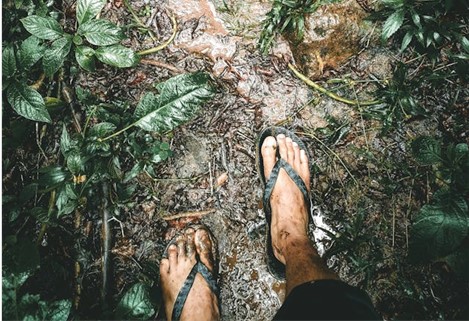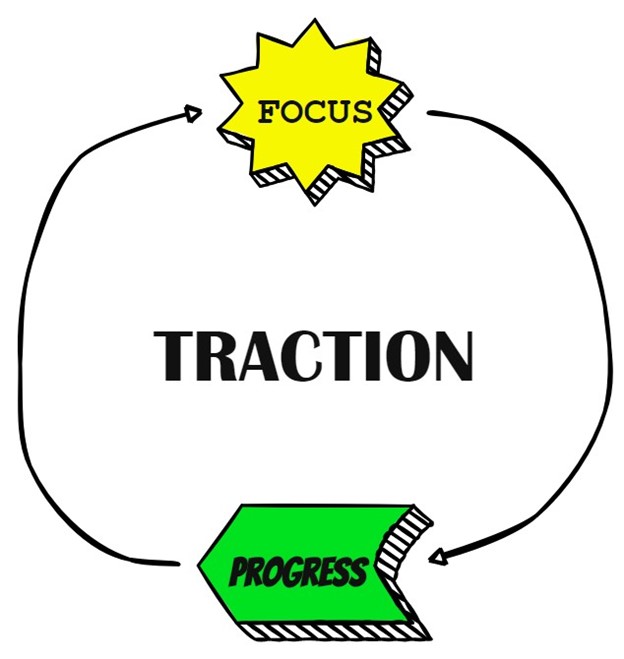
Imagine walking up a muddy hill wearing flip flops.
Sure, you should focus on where you’re putting your feet, making a conscious effort to maintain balance and not slip. Certainly, you should not let your eyes or mind wander away from this difficult task.
But really, you should swap your flip flops for hiking boots and use trekking poles. That will make far more of a difference. Tools and tactics beat willpower and focus.
What’s the Opposite of Distraction?
Most people would say the answer is focus, but that’s not quite right. Focus is part of the answer, but there’s more to it, and the full answer is a lot more helpful than being told to “just focus” or “just resist distractions.”
I’m reading Nir Eyal’s great book Indistractable, and the first insight is that the opposite of distraction is traction.1 It’s one of those semantic insights that’s only obvious after someone points it out, like how a “passport” is what allows you to “pass” through a “port.”
Traction is what allows you to make forward motion. Focus is a part of this, but perhaps more important are the tools, techniques, and strategies that make progress easier, like the hiking boots and trekking poles we used earlier.

Traction is the Combination of Focus and Progress
It’s obvious that focus leads to progress. When you keep your mind on the work at hand, you get things done. What’s less obvious is how progress creates focus.
When you make progress, it’s emotionally satisfying; your brain produces a reward – dopamine. Dopamine not only feels good, but it also urges you to do more of the same. So if you make some progress by focusing on a task, your brain biochemically encourages you to continue focusing on that task. This leads to more progress, in a positive feedback loop.

Therefore, things that make progress easier also make focus easier. So rather than devoting willpower to avoiding distractions, find ways to make it mechanically easier to do the work.
Increase Your Traction
I could never get myself to focus on making videos. Editing was just too hard, too daunting. I was wearing flip flops and staring up a muddy slope.
But then I found a tool, Pictory.AI, that makes it radically easier to edit video. This increase in traction ended years of procrastination overnight, and I now have a YouTube channel.
What about you?

What organizational tools would make your job easier?
How can you design your home environment to facilitate the good habits you’re trying to perform? (See: Using Mise En Place for Home, Work, and Life)
Which problem-solving strategies can simplify your challenges?
These mechanical solutions exist; you just have to go find them.
I’ve seen this work countless times with students. They can’t find the traction to get their homework done, so they turn to distractions. Then I come in and increase the traction:
- I help them set up organizational systems, and suddenly homework isn’t so overwhelming.
- I encourage their parents to create a dedicated home study space, which makes it easier for the student to find the tools they need to quickly get going.
- I teach students problem-solving strategies, so they can handle challenging questions without getting stuck.
When progress comes easier, it’s easier to stay focused.
Why We Turn to Distractions
We turn to distractions when we lose traction, when it feels like we’re just spinning our wheels. After all, if you can’t get anywhere, why try to keep focusing? Why not allow yourself to be distracted by things other than your task?

You can turn to distractions even when you’re making progress, of course, and this causes you to lose traction. Getting sidetracked by Instagram while working on a project stops your forward movement. Interrupting your writing to answer a text causes you to lose your train of thought.
But it’s also true that distraction results from losing traction. You falter, make a mistake, get stuck, etc., and progress halts. This feels bad. Suddenly, your brain is searching for easy dopamine, so distractions are more tempting.
What to do Instead
It’s inevitable that you’ll lose traction in the middle of your work. When it happens, you need to recognize the problem for what it is.
It’s not a sign that you should give up and reach for your go-to distraction. It’s a sign that you should reach for a tool or a technique that will get you moving forward again.
That’s the proactive way to overcome distractions, and it actually takes a lot less willpower than trying to “just resist distractions.”
1 Eyan, Nir. Indistractable: How to Control Your Attention and Choose Your Life. BenBella Books, 2019. Video book summary.
